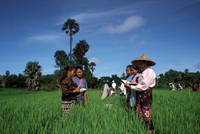Measuring tools and indicators

Below are some examples of these methodologies. Some are specialized in gathering environmental data, others focus on social impacts. Some are simpler than others, but if used more often, they can increase the level of rigor of the methodology. By combining several of these methods, the level of rigor can also increase.
Environmental impacts
Environmental impacts
| Social and biodiversity Impact assessment (SBIA) Manual for REDD+ Projects provides tools to guide practitioners to monitor environmental and social impacts relating to specific CCB Standard Certification criteria. |
| IIED - Poverty and Conservation Learning Group Guides for practitioners on Environmental Impact Assessment (EIA) and Strategic Environmental Assessment (SEA) methods for biodiversity in relation to CBD requirements. |
Social impacts
Social impacts
| IIED - Poverty and Conservation Learning Group Multiple tools and methodologies to assess the impact of initiatives on socio-economics and biodiversity. These also include valuation methodologies and frameworks to guide decision-making. |
| Information to design livelihood surveys that document the impact of co-benefit conservation interventions on local welfare. |
| Wide set of rapid pariticipatory assessment methods on economic and non-economic contributions from forests to households. A guide to support capacity building and training of these tools is also included. |
| Assessing the Impact of Development Programmes on Food Security E-learning course from FAO providing guidelines on: |
Standards and guidelines to monitor ecosystem services
Standards and guidelines to monitor ecosystem services
Voluntary standards and certification systems are third party-assessed norms and standards relating to the provision of ecosystem services and improved land management. They provide guidelines and promote the adoption of more sustainable agricultural production practices. Monitoring techniques from the tools above can be used to assess and demonstrate performance of initiatives against the standards and guidelines outlined below:
| Verified Carbon Standard (VCS) verifies the delivery of carbon benefits through Verified Carbon Units (VCUs). Projects must be transparent, real, measurable and conservative, demonstrate additionally, and uniquely registered. |
| The Climate, Community and Biodiversity Alliance (CCBA) verifies the integration of best-practice and multiple-benefit (climate, community and biodiversity impacts) approaches to land-based carbon project design and implementation |
| REDD+ Social and Environmental Standards promotes high social and environmental performance of government-led REDD+ programs that contribute to human rights, poverty alleviation, and biodiversity conservation. The standard supports the development of country-led, multi-stakeholder safeguards information systems and are complementary to carbon accounting standards http://www.redd-standards.org/redd-ses/process-for-using-redd-ses |
| The Wildlife Friendly Enterprise Network (WFEN) facilitates and certifies through peer-reviewed sustainable production practices of enterprises that protect wildlife in wild places. They assist network members to access new and dynamic markets, implement systematic monitoring and evaluation to ensure continued conformity to best practice standards, and facilitate enterprise development, education and branding. |
| Plan Vivo Standard for Community Payments for Ecosystem Services (PES) proposes a certification framework that seeks to support rural communities improve land management practices that benefit ecosystem services. It enables access to funding sources and markets for ecosystem services schemes. Certified projects must demonstrate additionality, positive socio-economic and livelihood impacts, and equitable benefit sharing through direct community engagement, good governance, accountability, and transparent project design. |








